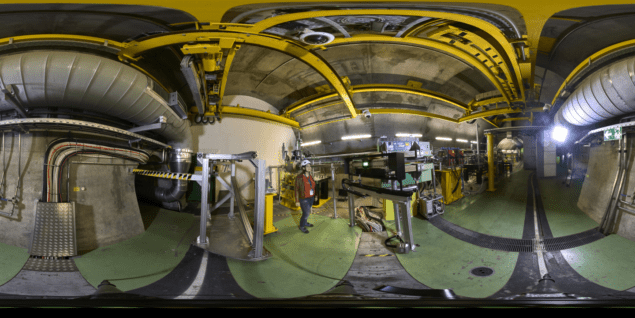
A beam of protons has been used for plasma wakefield acceleration for the first time, driving electrons to energies of 2 GeV over a distance of just 10 m. The technique was developed by CERN’s AWAKE collaboration and is still preliminary, but it could potentially accelerate fundamental particles to very high energies.
CERN’s Large Hadron Collider (LHC) accelerates protons to 6.5 TeV before smashing them together at a combined energy of 13 TeV. Protons are relatively heavy and comprise three quarks, which means that the collisions produce huge quantities of particles that must be detected and analysed.
 Advertisement
Advertisement
While sifting through the debris of these collisions has led to important discoveries – including the Higgs boson – it is a complicated and data intensive process. As a result, some particle physicists have proposed that the next big collider after the LHC should use lighter, fundamental particles such as electrons and positrons. This would result in much “cleaner” collisions that produce far fewer particles.
The problem is that circular accelerators like the LHC are ill-suited to colliding light fundamental particles. Accelerating charged particles in curved paths causes them to emit synchrotron radiation, and light particles lose much more energy in this process than heavier ones. Therefore, most designs for fundamental particle colliders are linear. The International Linear Collider – proposed for construction in Japan – would need to accelerate electrons for over 11 km to reach 0.25 TeV.
Plasma surfing
Plasma wakefield acceleration offers a very differ way of accelerating electrons over much shorter distances. An intense pulse of particles or laser light is fired into a plasma, separating electrons from ions to create a huge electric field that propagates like a ship’s wake (the wakefield) behind the pulse. If electrons are injected at precisely the right time, they can surf this wave and be accelerated to very high energies over relatively short distances.
Much as larger wakes can be created by larger ships, larger wakefields can be created in plasmas by using more energetic pulses. Previous experimental demonstrations of plasma wakefield acceleration have used either laser pulses or electron bunches to create the necessary wakefields. Unfortunately, the maximum energy that can be packed into a single laser pulse, for example, is around 1 J, which means complex, multi-stage accelerators would be required to accelerate electrons to the highest energies.
Protons, however, are relatively easy to accelerate and in 2009, Allen Caldwell of the Max Planck Institute for Physics in Munich and colleagues proposed that a 100 micron-long proton bunch could accelerate electrons to over 0.5 TeV in less than 500 m. There was one problem with this scheme – 100 micron-long, ultradense proton bunches do not yet exist.
Self-modulating bunches
The bunches from CERN’s Super Proton Synchrotron used by AWAKE are around 10 cm long so the team first fire a bunch into a plasma, which causes it to “self-modulate” into a series of shorter bunches. “These small bunches are shorter and denser,” explains AWAKE member Matthew Wing of University College London. “Their electric fields are completely in phase, so they constructively interfere to drive stronger and stronger wakefields."
Plasma physicist Sébastian Corde of Laboratoire d’Optique Appliquée in France is impressed: “This solves a lot of potential issues that we have in plasma acceleration,” he says. He cautions, however, that much work remains: “For every 2600 electrons injected, only one gets trapped into the plasma wave and accelerated…Clearly that’s something they’ll have to work on.”By injecting electrons near the back of the bunch, the researchers accelerated them to 2 GeV in just 10 m of plasma. “Our theoretical colleagues have shown that, if you take the LHC bunch as it is right now, you could accelerate electrons to roughly 1 TeV in just over 1 km and get to 6 TeV in about 8-10 km,” says Wing. “We need to do further R&D to demonstrate that it’s possible to get up to those high energies with excellent beam qualities but hopefully this will kick start people to think how this could be incorporated into a design for a future collider.”
Wim Leemans, director of the Berkeley Lab Laser Accelerator Center in California, adds “Having been in [plasma wakefield acceleration] for over three decades, I find it very important that CERN – the major high-energy physics lab in the world – has started investing in this technology”.
The research is described in Nature.
No comments:
Post a Comment